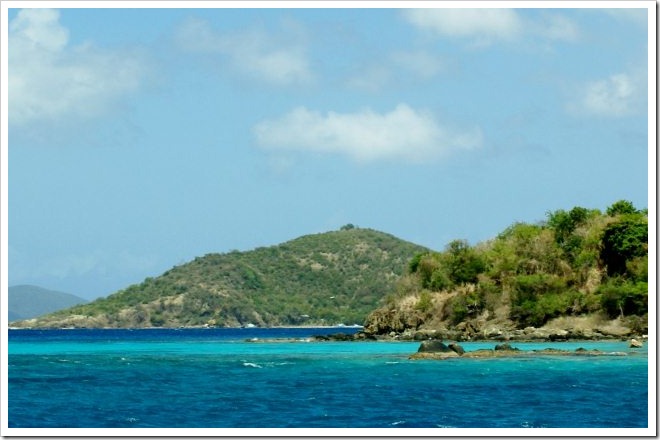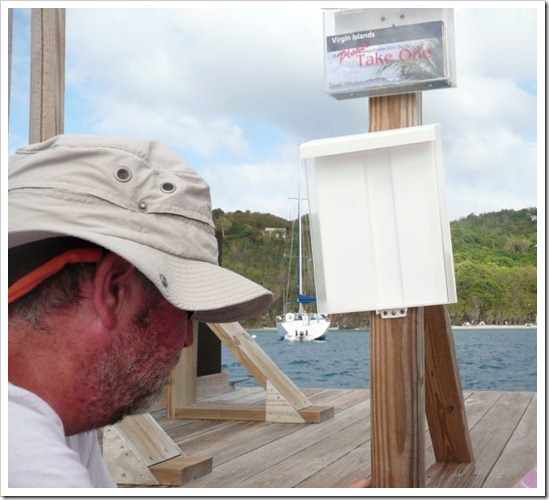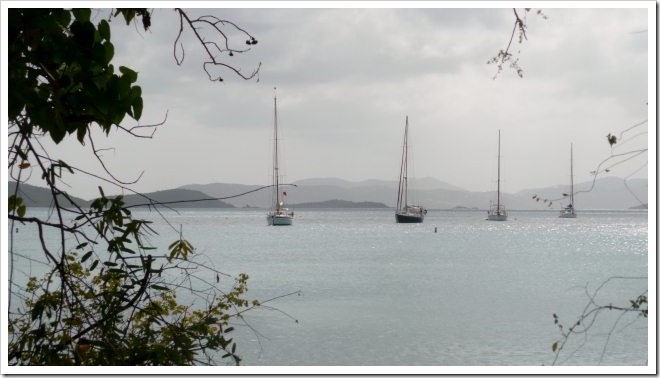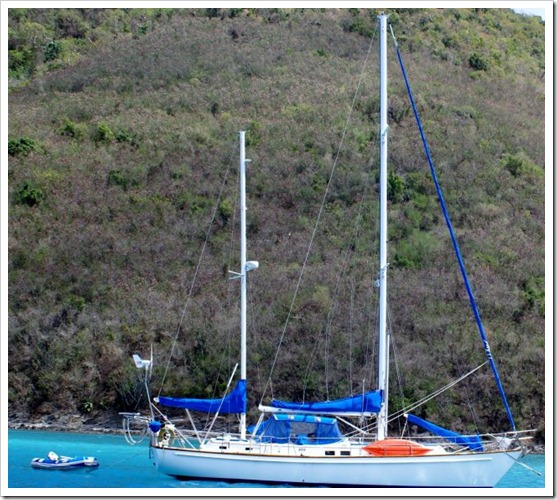26 Apr - 3 May 2011- US Virgin Islands (USVI) - St John

Nimue
Tue 3 May 2011 03:56
|
As our weather window for getting north up to the USA was reducing, we
only allowed ourselves a week in the USVI, which really wasn’t long enough to do
these islands justice.
Although we were only crossing a few miles from the BVI’s into
the USVI, entry procedures into US waters are very strict. After a lively
sail with Scott Free to Cruz Bay, a port of entry on St Johns, we made straight
for Customs and Immigration, where we had to produce our USA 10 year Visa for
the first time (which we had spent all day waiting for at the US Embassy in
London back in 2010)! Once all the paperwork was complete and our finger
prints matched to the one’s taken at the Embassy we were granted entry and I
must say all the officials were so polite and friendly (quite different to some
officials we encountered in the BVI’s).
The American Virgins once Danish, were bought by the USA in
1917 as a Caribbean base and to cover the approaches to the Panama Canal.
The USVI are self-governing and attached to the USA, but not integrated as part
of the union, although there is a voting delegate from the USVI in the US House
of Representatives. USVI nationals resident in the USVI, are US
citizens, but are unable to vote for the US President or members of the US
Houses of Congress. The territory includes three main islands, St John, St
Thomas and St Croix (35M to the south of St John).
On our way to Francis Bay We left Cruz Bay to find a good anchorage in Francis Bay a few
miles up the coast. The general rule in the USVI’s is that where buoys
have been laid and are free, you must tie up to one in preference to
anchoring. We found a couple of empty one’s not too
far from the shore and couldn’t believe our eyes when we saw that we had moored
next to Rick and Lucy off Flying Cloud (first met on Beez Neez for New Year’s
Eve dinner).
Two thirds of St John is under the auspices of the National
Park Service and thus has ‘millions’ of rules and regulations. It was here that
we first encountered our first taste of US officialdom – this was due to the
fact that we had tied up our dinghy to one of the buoys, marking the bathing and
a no-go zone area for motorised boats. We thought this would be okay, as
it was too far to swim to the snorkelling area from the yachts and there was no
where else sensible to leave the dinghy. Wrong assumption; because as we
were snorkelling, we were approached by a ranger in a launch and he advised us
that we were not allowed to leave the dinghy attached to the buoy and had to
move it. Michael swam over to fetch the dinghy, but was not allowed to
start the engine as no engines were allowed within the buoy boundary. This
meant he had to swim towing the dinghy until it was out of the buoyed area, by
which time we had all finished snorkelling and hauled ourselves back into
it. Rick advised this was the first time he had seen a ranger and thought
it quite amusing that we had been caught and couldn’t wait to tell the ranger we
were English!
Payment for the buoys was 15 U$ per night, which you were
obliged to go to a wooden structure in the middle of the Bay, take a form,
complete your details and put the required amount money in an envelope and put
it into the post box?
Steve off Scott Free paying his dues at the pay station We did find out there was a channelled entrance to the shore,
so we took the dinghy and found the Francis Bay nature trail, which we meandered
around for about an hour.
Scott Free, Nimue and Flying Cloud in Francis Bay (not the dark hulled boat)
The start of the Francis Bay trail
A dried up lake seen on the nature trail
It’s not what it looks like:- a route march! It was great to catch up with Rick and Lucy and their friends
holidaying from the USA and we arranged to meet up again in Charlotte
Amalie.
Flying Cloud (sorry not the best picture) |
![US-Virgin-Islands-map[1] US-Virgin-Islands-map[1]](/ul/blog/mailasail.com/nimue@mailasail.com/125/pngCwjUUW_b4L.png)






